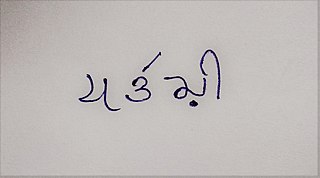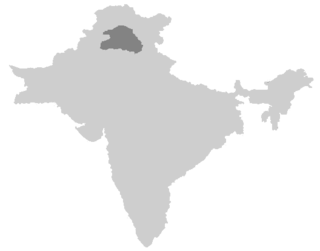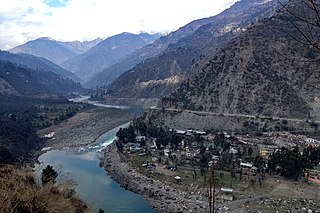| Takri 𑚔𑚭𑚊𑚤𑚯 [1] | |
|---|---|
| Type | |
| Languages | Dogri, Kangri, Sirmauri, Chamiyali, Mandeali |
Time period | 16 century CE to 19 century CE |
Parent systems | |
Sister systems | Gurmukhī |
| Direction | Left-to-right |
| ISO 15924 | Takr, 321 |
Unicode alias | Takri |
| U+11680–U+116CF | |
[a] The Semitic origin of the Brahmic scripts is not universally agreed upon. | |
| Brahmic scripts |
|---|
| The Brahmic script and its descendants |
Northern Brahmic |
The Takri script (Devanagari: टाकरी; sometimes called Tankri) is an abugida writing system of the Brahmic family of scripts. It is closely related to, and derived from, the Sharada script formerly employed for Kashmiri. It is also related to the Gurmukhī script used to write Punjabi. Until the late 1940s, an adapted version of the script (called Dogri, Dogra or Dogra Akkhar) was the official script for writing Dogri in the state of Jammu and Kashmir, and for Kangri, Chambeali and Mandeali in Himachal Pradesh. There is also some record of the script's use in the history of Nepali (Khas-kura).
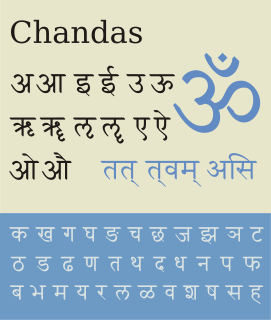
Devanagari, also called Nagari, is a left-to-right abugida (alphasyllabary), based on the ancient Brāhmī script, used in the Indian subcontinent. It was developed in ancient India from the 1st to the 4th century CE, and was in regular use by the 7th century CE. The Devanagari script, composed of 47 primary characters including 14 vowels and 33 consonants, is one of the most adopted writing systems in the world, being used for over 120 languages. The ancient Nagari script for Sanskrit had two additional consonantal characters.

An abugida, or alphasyllabary, is a segmental writing system in which consonant–vowel sequences are written as a unit: each unit is based on a consonant letter, and vowel notation is secondary. This contrasts with a full alphabet, in which vowels have status equal to consonants, and with an abjad, in which vowel marking is absent, partial, or optional. The terms also contrast them with a syllabary, in which the symbols cannot be split into separate consonants and vowels. Abugidas include the extensive Brahmic family of scripts of South and Southeast Asia, Semitic Ethiopic scripts, and Canadian Aboriginal syllabics.

The Śāradā, Sarada or Sharada script is an abugida writing system of the Brahmic family of scripts. The script was in widespread use between the 8th and 12th centuries in the northwestern parts of India, for writing Sanskrit and Kashmiri. The Gurmukhī script was developed from Śāradā. Originally more widespread, its use became later restricted to Kashmir, and it is now rarely used except by the Kashmiri Pandit community for ceremonial purposes.
Contents
Takri itself has historically been used to write a number of Dardic and Western and Central Pahari languages in the Western Himalaya, such as Gaddi or Gaddki (the language of the Gaddi ethnic group), Kashtwari (the dialect centered on the Kashtwar or Kishtwar region of Jammu and Kashmir) and Chamiyali (the language of the Chamba region of Himachal Pradesh). Takri used to be most prevalent script for business records and communication in various parts of Himachal Pradesh including the regions of Chintpurni, Una, Kangra, Bilaspur and Hamirpur. The aged businessmen can still be found using Takri in these areas, but the younger generation have now shifted to Devanagari and even English (Roman). This change can be traced to the early days of Indian independence (1950s−80s).
The Dardic languages are a sub-group of the Indo-Aryan languages natively spoken in northern Pakistan's Gilgit Baltistan and Khyber Pakhtunkhwa, northern India's Jammu and Kashmir, and eastern Afghanistan. Kashmiri/Koshur is the most prominent Dardic language, with an established literary tradition and official recognition as one of the official languages of India.
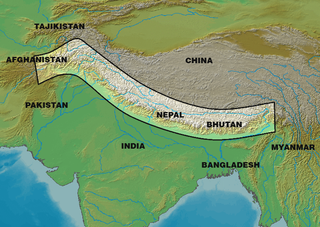
Western Himalaya, refers to the western half of the Himalayan Mountain region, stretching from Badakhshan in northeastern Afghanistan/southern Tajikistan, through India to central Nepal.
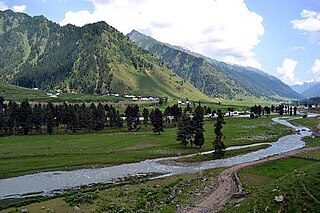
Kishtwar is a municipality in the Kishtwar District of the Jammu region in the Indian state of Jammu and Kashmir.



